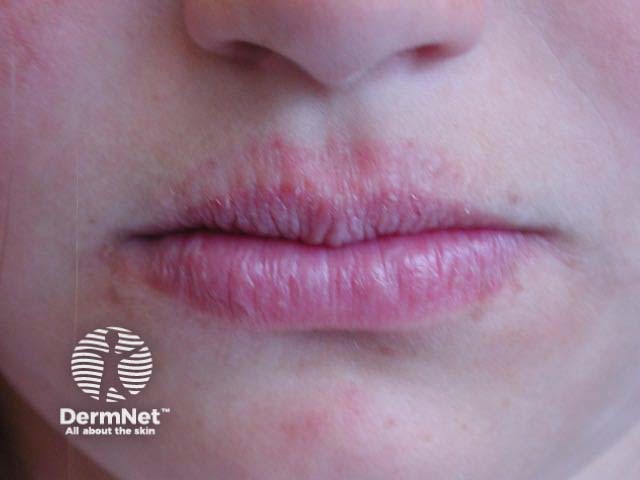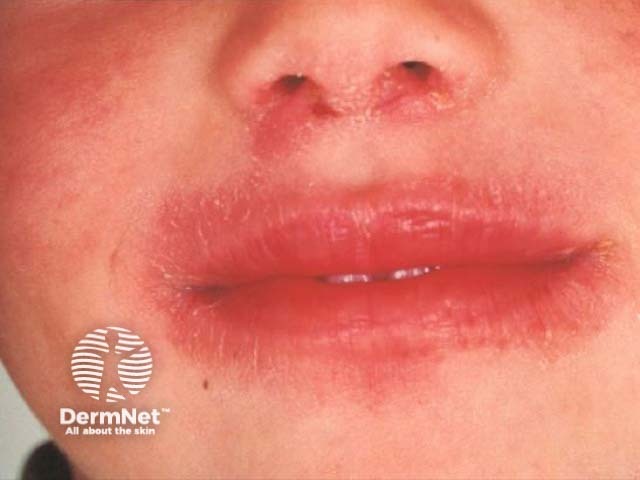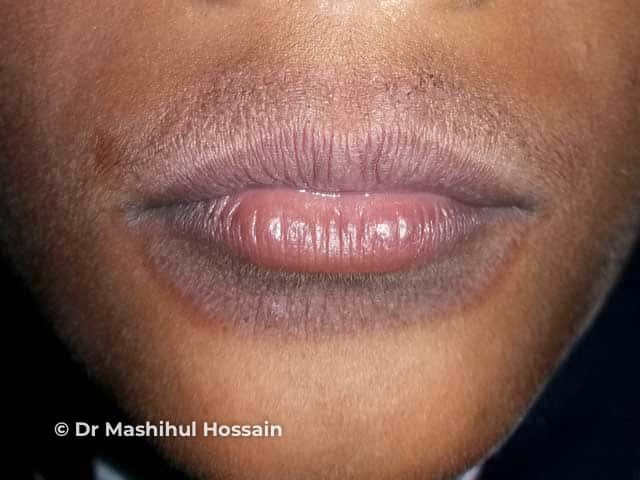Main menu
Common skin conditions

NEWS
Join DermNet PRO
Read more
Quick links
Lip licker’s dermatitis — extra information
Lip licker’s dermatitis
Authors: Dr Chioma Enweasor, Clinical Fellow, Department of Rheumatology/Allergy and Clinical Immunology, University of California, Davis, School of Medicine, Sacramento, CA, USA; and Dr Sean Deane, Senior Physician, Allergy and Immunology, The Permanente Medical Group, Sacramento, CA, USA. DermNet Editor in Chief: Adjunct A/Prof Amanda Oakley, Dermatologist, Hamilton, New Zealand. Copy edited by Mary-Elaine Luther/Gus Mitchell. January 2020.
Introduction
Demographics
Causes
Clinical features
Complications
Diagnosis
Differential diagnoses
Treatment
Outcome
What is lip licker's dermatitis?
Lip licker’s dermatitis is a reaction of the lips (eczematous cheilitis) and surrounding skin (irritant contact dermatitis) due to contact with an irritating substance — in this case, saliva from the patient’s own tongue [1,2].
Other names for lip licker's dermatitis are lip-lick cheilitis, irritant contact cheilitis due to lip-licking, lip-licking eczema, saliva-induced contact dermatitis and irritant contact dermatitis due to saliva.



How do you get lip licker's dermatitis?
Lip licker’s dermatitis is commonly seen in school-aged children, although it may present at any age [2,3]. In some patients, difficulty with impulse control or cognitive impairment contributes to compulsive lip-licking [4,5].
How does lip-licking cause dermatitis?
Lip-licking may begin with or without an initial stimulus, such as chapping in cold, dry weather.
- The patient engages in constant — often unconscious — lip-licking, rewetting the skin with saliva.
- The constant wet-dry cycle of saliva due to repeated lip-licking disrupts the normal skin barrier function and causes inflammation.
- Ongoing inflammation drives further lip-licking, perpetuating the cycle [1,3].
Lip licker's dermatitis — the tongue is the cause


What are the clinical features of lip licker's dermatitis?
Lip-licking creates chronic redness, dryness, and scaling of the lips and surrounding skin typically in a distribution that corresponds to the reach of the patient’s tongue.
- The area of inflammation frequently crosses the vermilion border of the lip.
- Symptoms can worsen during winter.
- The patient often complains of burning and dryness [1–3].

Lip licker's dermatitis
What are the complications of lip licker's dermatitis?
Although lip-licking might seem like a benign habit, there are significant possible complications.
- Skin breakdown can lead to a secondary bacterial skin infection (usually Staphylococcus aureus) or yeast infection (Candida albicans).
- Chronic inflammation may result in long-term postinflammatory hyperpigmentation or hypopigmentation [4].
How is lip licker's dermatitis diagnosed?
Lip licker’s dermatitis is usually diagnosed clinically, based on the characteristic appearance. Lip-licking may be observed during the evaluation, but direct observation is not required.
Skin biopsy is generally not indicated [3].
What is the differential diagnosis for lip licker's dermatitis?
Conditions that are often confused with lip licker's dermatitis include:
- Allergic contact cheilitis and allergic contact dermatitis — a hypersensitivity reaction following contact with an allergen often occurring intermittently; this is often localised and variable in appearance
- Periorificial dermatitis — this does not involve the vermilion of the lip or the skin immediately adjacent to the lip and generally causes papules.
What is the treatment for lip licker's dermatitis?
Behaviour modification to reduce lip-licking is essential. Treatment may include:
- Emollient lip balm
- Mild to moderate-strength topical corticosteroid (eg, hydrocortisone ointment)
- A topical calcineurin inhibitor (tacrolimus ointment or pimecrolimus cream).
What is the likely outcome for lip licker's dermatitis?
Lip licker’s dermatitis often resolves with appropriate treatment but may recur or require long-term treatment if lip-licking behaviour cannot be corrected [5].
References
- Rietschel RL, Fowler JF, Fisher AA. Fisher’s Contact Dermatitis. Hamilton: BC Decker Inc, 2008.
- Lim SW, Goh CL. Epidemiology of eczematous cheilitis at a tertiary dermatological referral centre in Singapore. Contact Dermatitis. 2000;43(6):322–6. doi:10.1034/j.1600-0536.2000.043006322.x. PubMed
- Zoli V, Silvani S, Vincenzi C, Tosti A. Allergic contact cheilitis. Contact Dermatitis. 2006;54(5):296–7. doi:10.1111/j.0105-1873.2006.0698b.x. PubMed
- Hisa T, Hamada T, Hirachi Y, Yoshioka M, Takigawa M, Shigenaga Y. Senile lip licking. Dermatology. 1995;191(4):339–40. doi:10.1159/000246591. PubMed
- Harth W, Gieler U, Kusnir D, Tausk FA. Clinical Management in Psychodermatology. New York: Springer Science & Business Media, 2008.
On DermNet
